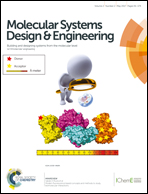Selective biomolecular separation system inspired by the nuclear pore complex and nuclear transport†
Abstract
Inspired by selective molecular transport in the nuclear pore complex, a system that can separate proteins using a facilitated diffusion-based mechanism is developed. The system is comprised of two components: nuclear transporter receptors (NTRs) fused with a peptide tag that can “catch” target biomolecules and a nucleoporin-like protein (NLP) hydrogel that can selectively “trap” target molecule-NTR complexes due to the physical binding between hydrophobic Phe-Gly sequences in the protein polymer network and the NTR. Similar to the nuclear pore complex, substrate selectivity is achieved via complexation with NTRs, which permits transport into the gel, whereas environmental proteins are rejected. The NLP hydrogel effectively transports cargo complexes down to the single nanomolar range in the environment, and a selectivity of approximately 300 can be achieved between target molecule and protein impurity. High selectivity requires both interactions between the hydrogel and cargo complex for efficient “catching” as well as high NLP gel concentration to reduce the pore size for rejecting environmental molecules. As a proof of concept of “catch-trap” for a protein target, a partial green fluorescent protein (GFP) sequence and staphylococcal enterotoxin B (SEB) toxoid are both separated from protein mixtures using engineered NTRs that contain binding tags for the corresponding protein. This represents a versatile system for fusing nuclear transporters with diverse peptide tags, enabling the selective binding and transport of a wide variety of separations of high value biomolecules.



 Please wait while we load your content...
Please wait while we load your content...